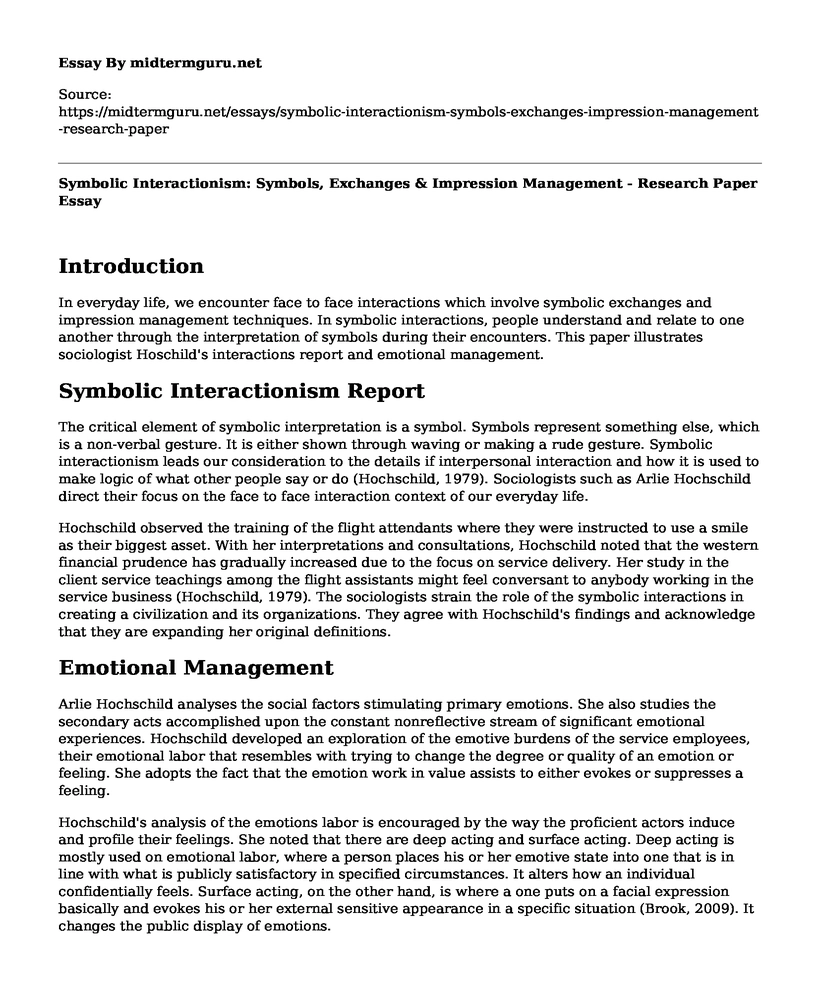Introduction
In everyday life, we encounter face to face interactions which involve symbolic exchanges and impression management techniques. In symbolic interactions, people understand and relate to one another through the interpretation of symbols during their encounters. This paper illustrates sociologist Hoschild's interactions report and emotional management.
Symbolic Interactionism Report
The critical element of symbolic interpretation is a symbol. Symbols represent something else, which is a non-verbal gesture. It is either shown through waving or making a rude gesture. Symbolic interactionism leads our consideration to the details if interpersonal interaction and how it is used to make logic of what other people say or do (Hochschild, 1979). Sociologists such as Arlie Hochschild direct their focus on the face to face interaction context of our everyday life.
Hochschild observed the training of the flight attendants where they were instructed to use a smile as their biggest asset. With her interpretations and consultations, Hochschild noted that the western financial prudence has gradually increased due to the focus on service delivery. Her study in the client service teachings among the flight assistants might feel conversant to anybody working in the service business (Hochschild, 1979). The sociologists strain the role of the symbolic interactions in creating a civilization and its organizations. They agree with Hochschild's findings and acknowledge that they are expanding her original definitions.
Emotional Management
Arlie Hochschild analyses the social factors stimulating primary emotions. She also studies the secondary acts accomplished upon the constant nonreflective stream of significant emotional experiences. Hochschild developed an exploration of the emotive burdens of the service employees, their emotional labor that resembles with trying to change the degree or quality of an emotion or feeling. She adopts the fact that the emotion work in value assists to either evokes or suppresses a feeling.
Hochschild's analysis of the emotions labor is encouraged by the way the proficient actors induce and profile their feelings. She noted that there are deep acting and surface acting. Deep acting is mostly used on emotional labor, where a person places his or her emotive state into one that is in line with what is publicly satisfactory in specified circumstances. It alters how an individual confidentially feels. Surface acting, on the other hand, is where a one puts on a facial expression basically and evokes his or her external sensitive appearance in a specific situation (Brook, 2009). It changes the public display of emotions.
Her research on emotional management mainly focuses on emotional labor which is a combination of emotional control and life managing. She refers to the work of managing one's own emotions that are required by certain professions. It detonates emotions labor that is executed on organizational and economic frameworks. She found that in the training of the employees of the organizations requires one to control their moods to generate an openly evident and suitable facial and physique presentation (Brook, 2009). The strategy is used to increase the economic success of an organization. Although she conducted the research within the United States, one of the worlds developed economies; her findings apply to many societies in the current age.
Symbolic interaction together with the language, allows people to be conscious beings. They can see themselves from outside as seen by others. Emotional labor, on the other hand, creates emotional management that can be useful in the workplace. Hochschild's findings relate to other sociologists researches who also found that trained employees are productive and competent social workers.
References
Hochschild, A. R. (1979). Emotion work, feeling rules, and social structure. American journal of sociology, 85(3), 551-575.
Brook, P. (2009). In critical defence of 'emotional labour' refuting Bolton's critique of Hochschild's concept. Work, employment and society, 23(3), 531-548.
Cite this page
Symbolic Interactionism: Symbols, Exchanges & Impression Management - Research Paper. (2023, Jan 08). Retrieved from https://midtermguru.com/essays/symbolic-interactionism-symbols-exchanges-impression-management-research-paper
If you are the original author of this essay and no longer wish to have it published on the midtermguru.com website, please click below to request its removal:
- Cause and Effect Analysis: Eating Disorders in Male
- Elements of Good Governance - Paper Example
- Paper Example on Deconstructing Relational Developmental Theory
- Strategies for Global Firms' Organizational Structure: Paper Example
- Obedience: Key to Social Functioning - Essay Sample
- Creating Perfection: The Beauty of Double Image Exposure on an Up North Image - Essay Sample
- Exploring Demographics in Carrollwood, Florida, USA - Essay Sample







